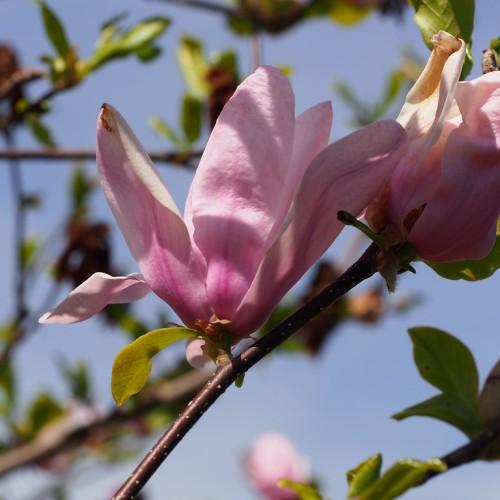
magnolia
Magnolia 'Ricki'
Cycle:
Perennial
Watering:
Average
Hardiness Zone:
4 - 8
Flowers:
Flowers
Sun:
Full sun,part shade
Leaf:
Yes
Growth Rate:
High
Maintenance:
Moderate
Care Level:
High
watering
Magnolia 'Ricki' should be watered on a regular basis, but not too often. During the warmer months when temperatures are above 60 degrees, water your magnolia once a week at the base of the trunk or root base. On colder days, reduce watering to once every 10-14 days. Make sure to water deeply to ensure that the root system is entirely wet. Water until the soil is slightly moist, but not soggy or waterlogged. Additionally, check the soil regularly. If the soil is dry, add more water.
sunlight
Magnolia 'Ricki' prefers full sun to partial shade, ideally receiving 4-6 hours of direct sunlight each day. If grown in direct sunlight all day, it may benefit from a little shade in the hottest part of the day. It is not particularly tolerant of intense heat and humidity, so during the heat of summer afternoon shade could benefit the plant and the blooms.
pruning
Magnolia 'Ricki' should typically be pruned in late winter or early spring. Generally, this species does not require pruning, unless necessary to control or maintain its shape, remove diseased, dead, or damaged branches, or to improve flowering. To prune this plant, select a few branches from the inside of the tree and remove any branches that are too long or bend toward the ground. Be sure to prune in an outward direction by steadily angling away from the center of the tree. When pruning, always use a clean, sharp pair of pruning shears to reduce stress and injury to the tree. After pruning, fertilize the plant if needed.
Season
Hardiness Map
FAQ
Is Magnolia a deciduous or evergreen plant?
Magnolia is a deciduous plant, meaning it drops its leaves annually. It is part of the Magnoliaceae family and has over 80 species found in the Northern Hemisphere. The large, showy flowers bloom in a wide range of colors from white to purple and appear before the foliage emerges in the spring. Depending on the species, some Magnolia trees may hold their leaves through the winter and drop them just before new growth emerges in the spring.
Are all Magnolia flowers fragrant?
No, not all Magnolia flowers are fragrant. Some, like the Star or Saucer Magnolias, are fragrant while others, such as the Loebner Magnolia, are not. There are over 200 species of magnolias, and not every one produces a scented bloom. Some magnolia flowers, however, have an unmistakable sweet smell. It is best to do research on the species of magnolias you are growing to determine if its flowers are fragrant or not.
Is Magnolia a good plant for attracting wildlife?
Yes, Magnolia is an excellent plant for attracting wildlife. Not only does it provide bright and fragrant blooms for pollinators to enjoy, but its large leaves provide protection for birds seeking a safe place to nest. Its multiple saucer-shaped blooms open up quickly in early spring, in turn providing a rich source of nectar for a variety of bees and butterflies. Additionally, many Magnolia trees produce a sweet sap that can be used to attract hummingbirds and other birds that are especially fond of the sugary treat.
Are there different varieties of Magnolia?
Yes, there are different varieties of Magnolia. There are more than 100 species of Magnolia that have been identified. These different types of Magnolias vary in size, shape, colour and form, giving gardeners the opportunity to choose from a wide range of plants for their gardens. Popular varieties include the Southern Magnolia, Star Magnolia, Saucer Magnolia, Genus Magnolia and Umbrella Magnolia. Each of these varieties offer something different and beautiful for a variety of landscapes.
Can Magnolia be propagated by cuttings?
Yes, magnolia can be propagated by cuttings. Cuttings should be taken from the stems of juvenile (2 years old or younger) plants, making sure to include one to two nodes. The nodes are the small bumps located on the stem where leafy shoots will emerge. The cuttings should then be immediately placed in a damp potting medium, such as sandy soil. If desired, one can also dip the cutting into rooting hormone prior to planting to speed the growth of roots. Properly watered and placed in indirect light, the cutting should begin producing roots in 4 to 6 weeks.
Could Magnolia be trained to grow on a trellis?
Yes, Magnolia can be trained to grow on a trellis. Establish a strong and sturdy trellis in a spot with full or partial sun and make sure it is in an area with good airflow. Plant the Magnolia tree at least two feet away from the trellis. When it starts to grow and get tall, train it to grow up the trellis by tying stems to the trellis and pruning the lower branches off. With routine training and pruning, it can be trained to the shape and height desired in no time.
Can Magnolia tolerate drought conditions?
Yes, Magnolia trees can tolerate drought conditions. They have relatively deep root systems which help them access water that is deeper in the soil, and they are often more drought-tolerant than many other plants. To help them during periods of drought, you should mulch around the base of the tree and keep it well-watered.
Can Magnolia be grown in a coastal area?
Yes, Magnolia can be grown in a coastal area. It is tolerant of salt spray and wet soils, making it an ideal choice for coastal gardens. Magnolia prefers well-drained soils, with pH levels of 6 to 7. When planting near the coast, make sure to select a variety that is suited to your climate and and give it plenty of space to grow. Using organic mulch and watering deeply during dry periods can also help protect the tree and keep it healthy.
